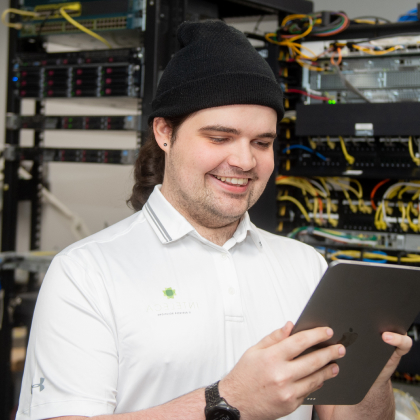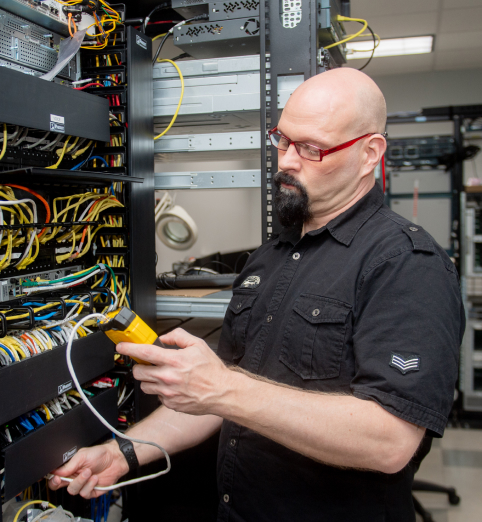To keep your network equipment running at peak performance, you need to ensure it’s properly serviced and maintained. But the cost of network upkeep can take a huge chunk out of your IT budget.
Companies looking to reduce excess costs to their IT budget, without sacrificing their equipment’s efficiency, should examine their options for network maintenance.
When it comes to network support, there are two main options:
- Support from your original equipment manufacturers (OEM)
- Support from a third-party maintenance provider (TPM)
Here’s a way to think about the difference. What we’ve got here is a kind of buddy cop movie situation. In any good crime story, you’ve got your cop who is totally loyal to the system and does things “by the book.” Then, you’ve got the “think outside the box” cop who’s willing to think creatively and work outside of the system to get results.
In the end, it usually takes both viewpoints to get justice. In this case, it’s justice for your investment in your network.
What is OEM Maintenance?
When companies purchase their hardware products (like networks, servers, and storage) from well-known brands such as NetApp, Cisco, or HPE, they typically come with an initial warranty period of 1-3 years in which the company offers support and routine maintenance services. Once that warranty expires, there are often post-warranty service solutions offered, but at an additional cost.
If you haven’t guessed it already, this is the “by the book” approach to maintenance.
Commonly, an OEM phases out older equipment according to their predetermined schedule. This makes the need to upgrade and buy new equipment a necessity, and “the book” in this case is clearly written in the OEM’s favor.
What is Third-Party Maintenance?
Simply put, Third Party Maintenance is IT hardware support provided by someone other than the OEM. This is sometimes also referred to as a TPM or independent provider.
TPMs provide excellent service for your equipment, and because they aren’t beholden to a single OEMs expectations on pricing, new product rollouts, and life expectancy of the gear, they can “think outside the box” when offering service.
This has a wide range of benefits:
- You gain a wider perspective on maintenance and the ability to service multiple vendors’ tech at once.
- Service is faster and less expensive.
- It’s easier to extend the lifespan of your hardware.
Narrow vs Wide Perspectives on Network Maintenance Solutions
One of the issues to consider with post-warranty support from an OEM is their limited viewpoint. They’re focused on servicing their own equipment. Sure, some OEMs do offer cross-vendor support and offer basic support for equipment from other companies, but these services are usually charged at a premium rate.
However, for third-party providers, this kind of cross-vendor service is the standard. TPMs are usually certified at the same technical level as OEM support, and they can troubleshoot a wider range of brands and equipment models.
With TPM service, you can deal with all of your network problems through a single point of contact. Your solutions come from engineers who can see beyond the OEM’s viewpoint and have experience with multiple vendors’ tech.
Faster, Less Expensive Maintenance Solutions
A TPM provider often offers a faster, more flexible approach to service requests. Service is their first priority. And, with access to a varied inventory of refurbished parts, they can find creative solutions since most data centers use equipment sourced from several different OEMs.
Also, a TPM is typically less expensive than the post-warranty support you can purchase from the original equipment manufacturer. Remember, an OEM is focused on hardware sales. Their maintenance costs will reflect the idea that they would rather you purchase new equipment. A TPM is focused on service. They have less overhead than a manufacturer, and their business model and pricing is built around service.
Differing Viewpoints on the Life Expectancy of Network Hardware
When it comes to maintaining IT efficiency, there’s also the very important factor of equipment warranty. Most OEMs will advise you “by the book” to replace your equipment before its end of life (EOL) date.
However, the average functional lifespan of your hardware is often more than double what your OEM tells you, ranging from 18 to 33 years as opposed to the commonly quoted 5-10 years.
Lack of support from OEMs past this cut-off point can cause many users just to unnecessarily trash their old systems.
TMPs, on the other hand, offer extended support for your hardware by thinking outside the OEM’s box and seeing further value in your gear.
TPM’s Help Reduce Network Maintenance Costs for Your Business
Both your OEM and TPM are needed in this IT buddy cop story.
- We need the OEMs to think “by the book” about their own equipment! Thank goodness they keep a dogged eye on quality control and make conservative estimates about the capabilities of their hardware.
- However, we also need TPMs to “think outside the box” about what’s possible with maintenance. We need them to bring a wider perspective of how multiple OEMs’ products work together in a network and to see further potential in the functional life of your gear.
Together, an OEM focused on the quality of their own products and a TPM who can think outside the box in maintaining them bring full justice to your investment. This is how you extract maximum value and performance from your gear. This team-up is your “lethal weapon” for cost overruns. (That’s our only cop movie pun. We swear.)
Inteleca’s IT Maintenance Solutions is a cost-effective, TPM solution that helps you greatly reduce your IT maintenance budget. We cover all of your equipment, including legacy, end-of-life (EOL), and end-of-service (EOS) products that OEMs no longer support.
Contact us here to learn how you can avoid paying for a high-priced OEM maintenance plan while supporting and extending the life of your existing hardware.



